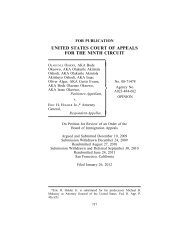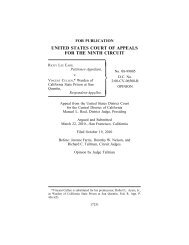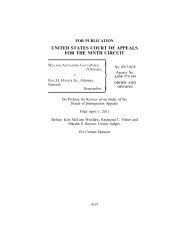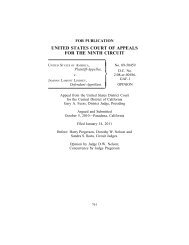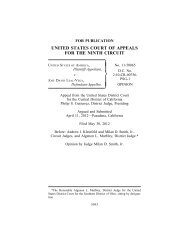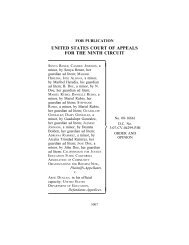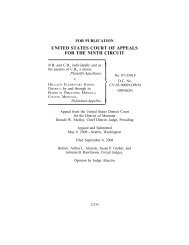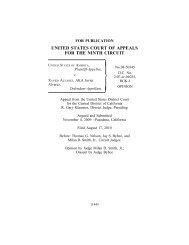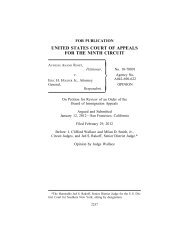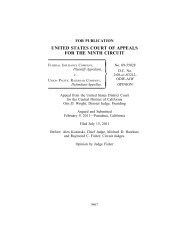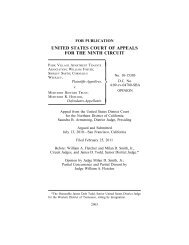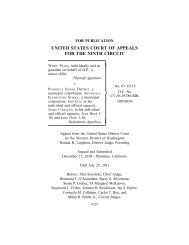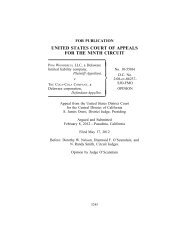kristin rossum v. deborah patrick - Ninth Circuit Court of Appeals
kristin rossum v. deborah patrick - Ninth Circuit Court of Appeals
kristin rossum v. deborah patrick - Ninth Circuit Court of Appeals
Create successful ePaper yourself
Turn your PDF publications into a flip-book with our unique Google optimized e-Paper software.
17412 ROSSUM v. PATRICK<br />
Respondent further claims that because toxicology labs<br />
rarely test for fentanyl, if one <strong>of</strong> Rossum’s coworkers was trying<br />
to frame her or Robertson, he would not have used fentanyl.<br />
The trial record suggests otherwise. OME employees<br />
could well have known that de Villers’s specimens would be<br />
sent to an outside lab, and that the first lab selected to analyze<br />
de Villers’s samples, Pacific Toxicology, did test for fentanyl.<br />
Moreover, the argument ignores the manner in which toxicology<br />
testing is ordinarily done. Dr. Blackbourne testified that<br />
if a toxicology lab’s initial testing fails to disclose a cause <strong>of</strong><br />
death, further tests are <strong>of</strong>ten conducted to determine if less<br />
common substances—like fentanyl—are present.<br />
In any event, contamination could have been definitively<br />
determined through testing for the presence <strong>of</strong> metabolites <strong>of</strong><br />
fentanyl, according to Dr. Richeimer’s declaration. 9 Although<br />
the Respondent notes that the absence <strong>of</strong> fentanyl metabolites<br />
would not have exonerated Rossum because she could have<br />
killed de Villers with another drug, it is highly unlikely that<br />
9 Respondent argued at the District <strong>Court</strong> that “Petitioner presents no<br />
evidence that the autopsy specimens were not already tested for the presence<br />
<strong>of</strong> metabolites,” and quoted directly from Dr. Richeimer’s declaration,<br />
“testing for these metabolites is commonly done by many<br />
laboratories.” Answer to Pet. for Writ <strong>of</strong> Habeas Corpus 15. At oral argument,<br />
however, Respondent instead claimed that a competent attorney<br />
would not have realized that de Villers’s samples could be tested for contamination<br />
by analyzing them for the presence <strong>of</strong> fentanyl metabolites.<br />
Respondent directed our attention to the cross-examination <strong>of</strong> toxicologist<br />
Michael Henson. Rossum’s attorney asked Henson, “Do you have any<br />
way <strong>of</strong> knowing or testing to determine if any [<strong>of</strong> de Villers’s] samples . . .<br />
has been tampered with or spiked by anybody?” Henson answered, “No.”<br />
ER 305. An answer given by a single prosecution witness during crossexamination<br />
cannot, however, be dispositive, particularly given Rossum’s<br />
allegation in her state habeas petition that her trial counsel “could have<br />
determined the viability <strong>of</strong> a contamination defense by having the specimens<br />
confidentially tested.” State Habeas Petition at 4, see also id. at 30.<br />
In any case, defense attorneys are obligated to pursue lines <strong>of</strong> investigation<br />
that hold out the promise <strong>of</strong> proving their clients’ innocence prior to deciding<br />
on a trial strategy. See Hart v. Gomez, 174 F.3d 1067, 1070-71 (9th<br />
Cir. 1999).



